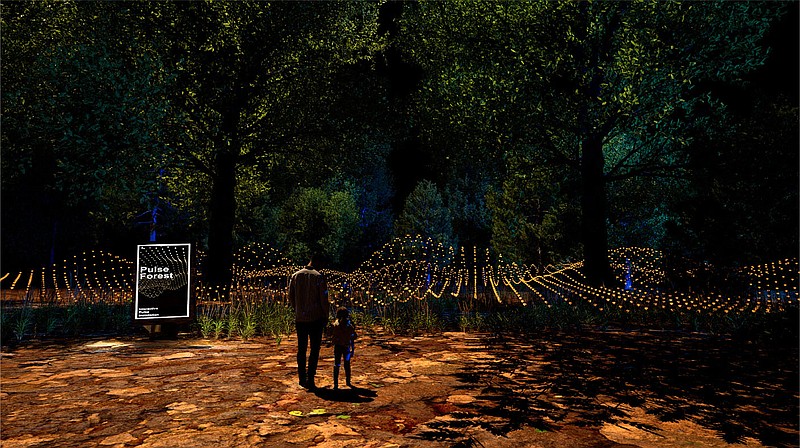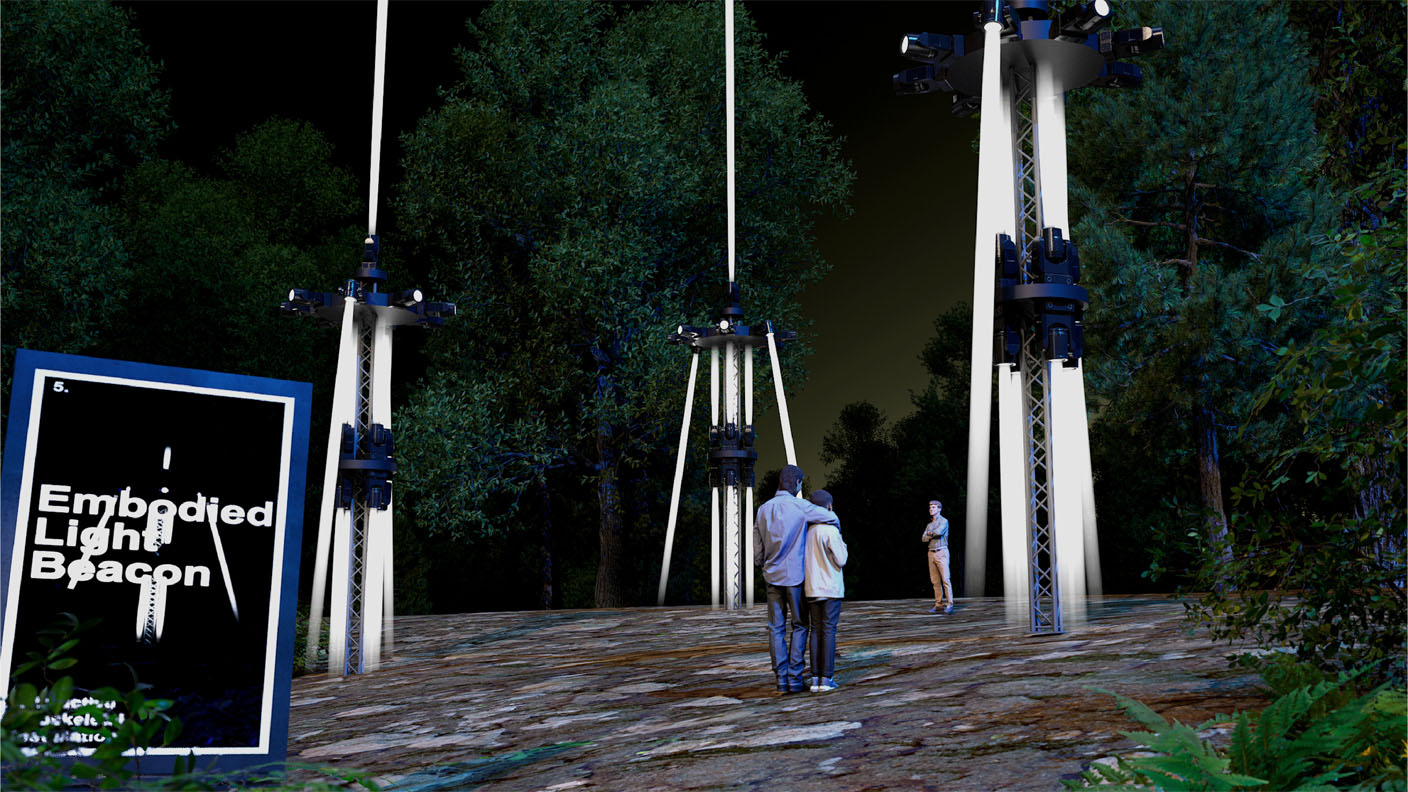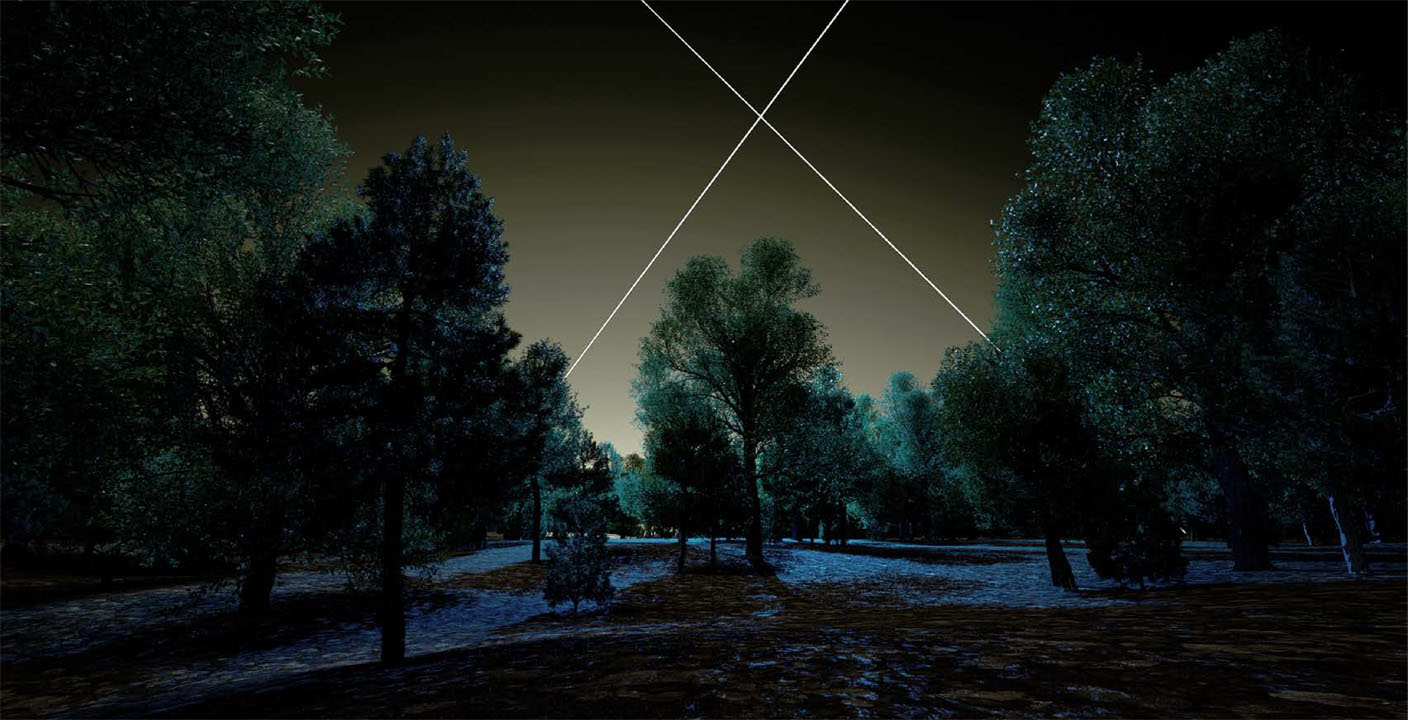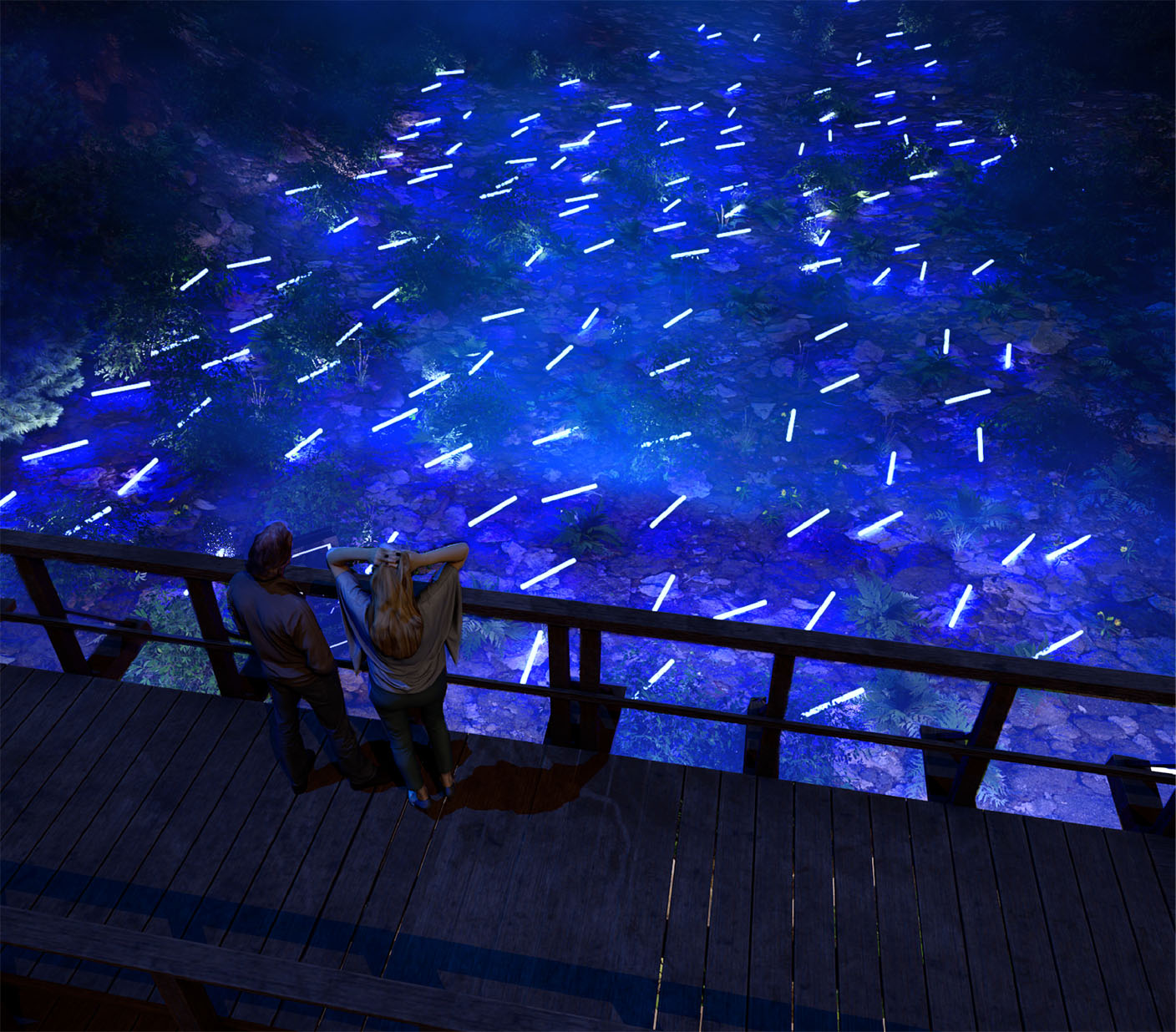Picture this. It's evening, getting dark. You're standing in the North Forest at Crystal Bridges Museum of American Art, and you hear something, the rhythms of 3,000 heartbeats. As you approach a certain grove of trees, you pick up on a subtle mix of whispering voices. Do you stop to add your own? When you get to the three enormous light robots, one of them begins to imitate your movements, and each one sets off swooping sounds.
The "Listening Forest" exhibition is an experience in every sense, says Alejo Benedetti, associate curator of contemporary art at Crystal Bridges, an experience which you really have to be there physically to fully understand.
If you enjoyed "North Forest Lights," the outdoor exhibit that ran last September through New Year's Day, you'll probably like the "Listening Forest," too, but just know it's entirely different, Benedetti cautions. "North Forest Lights" was a compilation of many artists' works, while "Listening Forest" is eight large, immersive works by Rafael Lozano-Hemmer. And rather than being something to see, this is something to participate in.
"With 'North Forest,' the spectator is moving through the forest," Benedetti says. "With every one of Rafael's works, the fact that you're in the forest and moving through it, (well,) your presence has an impact on the exhibition."
People walking through will find that their pulse affects lights, their voice and words can be mixed into various experiences, and their movements affect things too.
"Things we know to be true about Rafael, his artworks are stunning but also so thoughtful, with a marriage between beauty and concept that is always there with him; you can walk through and interact with the experience," Benedetti says.
The first Lozano-Hemmer work that Benedetti saw was something he observed remotely in 2012 called "Last Breath," a simple-on-the-surface piece in which a brown paper bag expanded and contracted. It had one person's breath inside, but the bag was connected to a machine to continue the action. Benedetti was struck by the poeticism of seeing a machine simulate such an innately human gesture. It stuck with him, this artist who explored the interaction between humans -- the things that unite and define us -- with technology elements and components on top of it.
Rafael Lozano-Hemmer, who was born in Mexico City and has a degree in physical chemistry, has been working for 30 years. Benedetti says each artwork has a technology component, that it's a part of his practice to include one. That tempts people to often describe his pieces as high tech or state-of-the art, but Lozano-Hemmer is quick to point out that those phrases make it sound like he's looking toward the future, when in fact technology has been in artwork for a long time. The way he sees it, he's merely entering a tradition that's already been well established. Lozano-Hemmer describes his own work as an intersection of architecture and performance art.
"The power of his work is that he's able to take complexity and find the beauty in it (along with) all the behind-the scenes heady tech work to get to this ... accessible gesture," Benedetti says.
Ordinarily Lozano-Hemmer's large pieces are exhibited one at a time, typically in urban areas like Milan, Sydney, New York, London, Moscow and other iconic metropolitan cities. That makes the "Listening Forest" the largest grouping of his work ever to be showcased in one place and a bit of a mid-career survey of his largest works.
It's also a unique time to see Lozano Hemmer adapt to showing his works off in an environment completely unfamiliar to him -- the Ozarks.
"The big thing here is an opportunity to get an incredible sense of the span of this artist's career so far," Benedetti says. "He hasn't really worked in a forest like this before, it's a first for him."
Working through the elements presents some new challenges, such as the problem of trying to install thousands of lightbulbs and electrical components and having to pause frequently for rain. Creating the pulse forest, in which 3,000 lightbulbs are working out in the Ozark topography, meant installing that many pieces of rebar in the forest floor, an arduous process that Benedetti says can't be rushed.
It also means scaling back on the brightness of many of the lighting components, since Lozano-Hemmer's works won't be competing with so much other light pollution.
"In the city, the intensity has to be so bright," Benedetti says. "Out in the forest (if it's still that bright, it's) like it's screaming at you, so it has to be pulled back."
Before arriving in Northwest Arkansas, Lozano-Hemmer's team consulted with ornithologists at the Audubon Society for the safest way to display one of his lighting works in particular -- which resembles two large spotlights aimed into the air -- while having the smallest impact on wildlife as possible. Birds are often flying their migratory paths at night, for example, and the artist wanted to make sure his work wouldn't affect those patterns.
If it sounds like the total effect of Lozano-Hemmer's works is to make visitors think twice about how their actions and movements affect the planet, that is in fact intentional. His daughter is what he calls an outspoken environmentalist, and Benedetti says that has seeped into Lozano-Hemmer's work as a way to do right by his kids and thoughtfully display art in a way that's safe for all forms of life in the area.
After having experienced Lozano-Hemmer's "pulse room," a series of 100 lightbulbs operating with the help of heart rate sensors, Benedetti expects that the pulse forest will be the crowd favorite.
"You wrap your hands around these two metal monitors and (it lights) one light bulb right in front of you," he says. "Eventually you have a room of 100 heart beats pulsing in beautiful syncopation. Even with 100, it was just stunning."
A custom soundtrack by the artist Scanner was created for the "Listening Forest," which brings those sound elements into play at exactly the right time and affects how you wind up listening to heartbeats in the forest.
Benedetti has asked Lozano-Hemmer whether they can say too much, give too much away about his work, but he's not concerned.
"You just have to be there, standing in this space, actually engaging with it," Benedetti says.
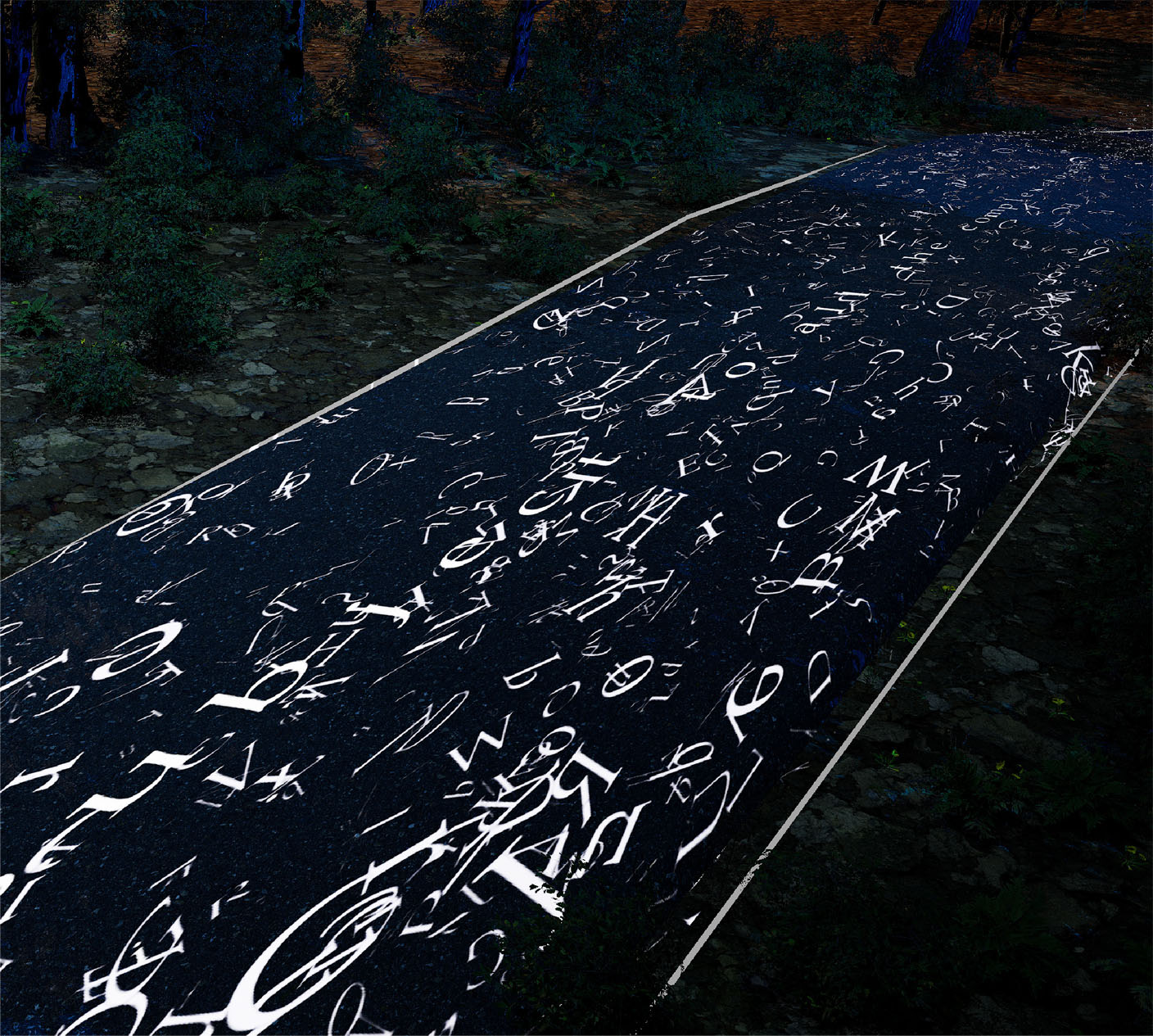 The Arkansas Text Stream project is one of the eight works within the "Listening Forest." Projectors allow letters to appear on the pavement down the forest trail and make it appear as if the letters are flowing downstream. When the letters get to a person who is walking along the trail, some stop to form a phrase for the person to read. The phrases were community sourced through the Pryor Center, Ozark Highlands Radio, a local poet and other community contributors, says outdoor interpretation specialist Samantha Best. (Courtesy Image/Antimodular Studio)
The Arkansas Text Stream project is one of the eight works within the "Listening Forest." Projectors allow letters to appear on the pavement down the forest trail and make it appear as if the letters are flowing downstream. When the letters get to a person who is walking along the trail, some stop to form a phrase for the person to read. The phrases were community sourced through the Pryor Center, Ozark Highlands Radio, a local poet and other community contributors, says outdoor interpretation specialist Samantha Best. (Courtesy Image/Antimodular Studio)
